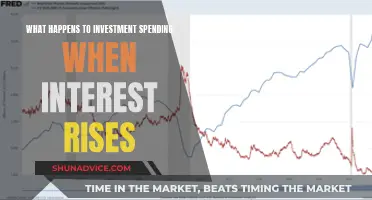
Interest elasticity of investment (IEI) is the responsiveness of investment to changes in interest rates. When interest rates are close to the expected return, elasticity is high. Conversely, when the expected return on investments is much higher than interest rates, elasticity is low. Other factors that affect IEI include investor confidence, economic growth, the willingness of banks to lend, and the state of technology. Additionally, when money is abundant, elasticity is high, and when money is scarce, elasticity is low.
| Characteristics | Values |
|---|---|
| Definition | Interest-elasticity of investment (IEI) is the responsiveness of investment to changes in interest rates |
| Factors affecting IEI | Expected return on investments, money supply, investor confidence, economic growth, the willingness of banks to lend, accelerator theory, state of technology, business confidence, and the negative accelerator effect |
| IEI during a recession | IEI may be more inelastic because of low business confidence and a negative accelerator effect |
| IEI and liquidity traps | In a liquidity trap, lower interest rates may have little effect on boosting levels of investment, making demand for investment very interest inelastic |
What You'll Learn
- The responsiveness of investment to changes in interest rates
- The impact of a recession on investment interest elasticity
- The relationship between expected return on investments and interest rates
- The effect of money supply on elasticity
- The role of investor confidence, economic growth, and other factors on investment interest elasticity

The responsiveness of investment to changes in interest rates
Interest elasticity is high when interest rates are close to the expected return on investments. For example, when money is abundant, the elasticity will be high. However, when money is scarce, the elasticity will be low.
There are other factors that affect the IEI. For instance, during a recession, the IEI may be more inelastic because of low business confidence and a negative accelerator effect. Other factors include investor confidence, economic growth, the willingness of banks to lend, accelerator theory, and the state of technology.
In a liquidity trap, lower interest rates may have little effect on boosting levels of investment. This happened during the Great Recession of 2009 when interest rates were cut to 0.5%, but the economy remained stagnant with little increase in investment.
Interest Rates: Saving vs Investing
You may want to see also

The impact of a recession on investment interest elasticity
Investment interest elasticity is the responsiveness of investment to changes in interest rates. When money is abundant, the elasticity will be high, and when money is scarce, the elasticity will be low.
During a recession, investment interest elasticity may be more inelastic because of low business confidence and a negative accelerator effect. This was seen during the Great Recession of 2009, when interest rates were cut to 0.5% but the economy remained stagnant with little increase in investment.
Other factors that can affect investment interest elasticity include investor confidence, economic growth, the willingness of banks to lend, and the state of technology. In a liquidity trap, where there is an abundance of money but low investment, lower interest rates may have little effect on boosting levels of investment.
Additionally, the expected return on investments can impact elasticity. If the expected return is much higher than interest rates, then elasticity will be low. When interest rates are close to the expected return, elasticity will be high.
Negative Interest Rates: Strategies for Smart Investing
You may want to see also

The relationship between expected return on investments and interest rates
Interest elasticity of investment (IEI) refers to the responsiveness of investment to changes in interest rates. When the expected return on investments is much higher than interest rates, the elasticity will be low. Conversely, when interest rates are close to the expected return, elasticity will be high.
For example, if inflation is 4% and nominal interest rates are 6%, the real interest rate is 2%. In this case, a fall in interest rates from 5% to 0.5% may have a very small impact on increasing investment. This happened during the Great Recession of 2009 when interest rates were cut to 0.5%, but the economy remained stagnant with little increase in investment.
Other factors that can affect the IEI include investor confidence, economic growth, the willingness of banks to lend, and the state of technology. In a recession, the IEI may be more inelastic due to low business confidence and a negative accelerator effect. Additionally, when money is abundant, the elasticity will be high, while scarcity will result in low elasticity.
Interest Rates: Impact on Investment Spending and the Economy
You may want to see also

The effect of money supply on elasticity
Investment interest elasticity is the responsiveness of investment to changes in interest rates. When money is abundant, the elasticity will be high, and when money is scarce, the elasticity will be low. The expected return on investments also affects elasticity: when the expected return is much higher than interest rates, elasticity will be low, and when interest rates are close to the expected return, elasticity will be high.
Other factors that affect investment interest elasticity include investor confidence, economic growth, the willingness of banks to lend, and the state of technology. During a recession, investment interest elasticity may be more inelastic due to low business confidence and a negative accelerator effect.
The money supply, therefore, has a direct effect on elasticity. When the money supply is high, there is more money available to invest, which increases the elasticity of investment. Conversely, when the money supply is low, there is less money available to invest, which decreases the elasticity of investment.
Investing: Interest and Cash Flow Interdependence
You may want to see also

The role of investor confidence, economic growth, and other factors on investment interest elasticity
Investment interest elasticity is the responsiveness of investment to changes in interest rates. When interest rates are close to the expected return, elasticity is high, and when the expected return is much higher than interest rates, elasticity is low.
Investor confidence, economic growth, the willingness of banks to lend, and the state of technology all play a role in investment interest elasticity. For example, during a recession, investment interest elasticity may be more inelastic due to low business confidence and a negative accelerator effect. Additionally, when money is abundant, elasticity tends to be higher, while it is lower when money is scarce.
The relationship between investment interest elasticity and economic growth can be complex. For instance, in a liquidity trap, lower interest rates may have little effect on boosting investment levels. This was observed during the Great Recession of 2009, when interest rates were cut to 0.5% but the economy remained stagnant with little increase in investment.
The Magic of Compound Interest for Long-Term Investments
You may want to see also
Frequently asked questions
The IEI is the responsiveness of investment to changes in interest rates.
The IEI is affected by the expected return on investments, the money supply, investor confidence, economic growth, the willingness of banks to lend, accelerator theory, and the state of technology.
During a recession, the IEI may be more inelastic due to low business confidence and a negative accelerator effect.







